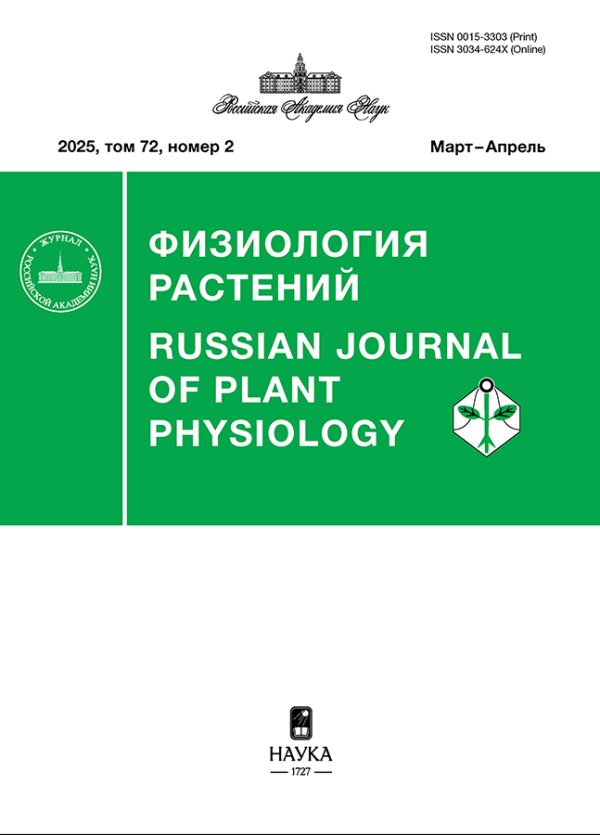Changes in the Content of Carotenoids in Moss Shoots Hylocomium splendens Hedw. under Conditions of Temperature Stress
- Authors: Renkova A.G.1, Khabibrakhmanova V.R.1,2, Gurjanov O.P.1, Galeeva E.I.1, Mazina A.B.1, Minibayeva F.V.1
-
Affiliations:
- Kazan Institute of Biochemistry and Biophysics, Kazan Scientific Center, Russian Academy of Sciences
- Kazan National Research Technological University
- Issue: Vol 70, No 7 (2023)
- Pages: 898-905
- Section: ЭКСПЕРИМЕНТАЛЬНЫЕ СТАТЬИ
- URL: https://journals.rcsi.science/0015-3303/article/view/233799
- DOI: https://doi.org/10.31857/S0015330323601000
- EDN: https://elibrary.ru/BELXXA
- ID: 233799
Cite item
Full Text
Abstract
The ability of plants to adapt to unfavorable living conditions is a necessary condition for the survival of plants, the preservation of the genotype, and the maintenance of flora diversity. A promising approach to solving the problem of increasing plant resistance is to study the mechanisms of stress resistance of “extremophiles”, including mosses, higher nonvascular plants. The relative simplicity of their anatomical structure and ability to survive in unfavorable environmental conditions make these evolutionarily ancient plants ideal models for studying adaptation mechanisms. It is known that the functional activity of the photosynthetic apparatus can change dynamically under the influence of stress factors. In this work, we conducted a study of stress-induced changes in the content of carotenoids in the forest moss Hylocomium splendens Hedw. under temperature stress conditions. We have identified the main carotenoids of H. splendens moss. It has been established that the relative content of lutein, β-carotene, and zeaxanthin increased under the influence of negative and elevated temperatures, while the total content of carotenoids decreased under temperature stress. It was shown that 1 h of exposure to unfavorable temperatures led to a significant decrease in nonphotochemical quenching of chlorophyll fluorescence a, with stronger changes observed when exposed to negative temperatures. Transcript level analysis of HsLUT1, one of the key genes for lutein biosynthesis, showed a significant increase of four to five times under temperature stress. Thus, our data revealed that changes in the expression of the carotenoid biosynthesis gene are accompanied by changes in their content under temperature stress. The data obtained expand our knowledge of resistance mechanisms in bryophytes and will contribute to the understanding of evolutionary changes in stress resistance in higher plants.
Keywords
About the authors
A. G. Renkova
Kazan Institute of Biochemistry and Biophysics, Kazan Scientific Center, Russian Academy of Sciences
Email: renkova@kibb.knc.ru
Kazan, Russia
V. R. Khabibrakhmanova
Kazan Institute of Biochemistry and Biophysics, Kazan Scientific Center, Russian Academy of Sciences; Kazan National Research Technological University
Email: renkova@kibb.knc.ru
Kazan, Russia; Kazan, Russia
O. P. Gurjanov
Kazan Institute of Biochemistry and Biophysics, Kazan Scientific Center, Russian Academy of Sciences
Email: renkova@kibb.knc.ru
Kazan, Russia
E. I. Galeeva
Kazan Institute of Biochemistry and Biophysics, Kazan Scientific Center, Russian Academy of Sciences
Email: renkova@kibb.knc.ru
Kazan, Russia
A. B. Mazina
Kazan Institute of Biochemistry and Biophysics, Kazan Scientific Center, Russian Academy of Sciences
Email: renkova@kibb.knc.ru
Kazan, Russia
F. V. Minibayeva
Kazan Institute of Biochemistry and Biophysics, Kazan Scientific Center, Russian Academy of Sciences
Author for correspondence.
Email: renkova@kibb.knc.ru
Kazan, Russia
References
- Sabovljevic M., Bijelovic A., Grubisic D. Bryophytes as a potential source of medicinal compounds // Med Raw. 2001. V. 21. P. 17.
- Krinsky N.I. Antioxidant function of carotenoids // Free Radical Biol. Med. 1989. V. 7. P. 617. https://doi.org/10.1016/0891-5849(89)90143-3
- Meier S., Tzfadia O., Vallabhaneni R., Gehring C., Wurtzel E.T. A transcriptional analysis of carotenoid, chlorophyll and plastidial isoprenoid biosynthesis genes during development and osmotic stress responses in Arabidopsis thaliana // BMC Syst. Biol. 2011. V. 5. P. 77. https://doi.org/10.1186/1752-0509-5-77
- Hashimoto H., Uragami C., Cogdell R.J. “Carotenoids and photosynthesis,” in Carotenoids in Nature. Springer: Cham, Switzerland, 2016. P. 111.
- Falkowski P.G., Raven J.A. Aquatic photosynthesis. Malden. USA: Blackwell Sci., 1997. 375 p.
- Дымова О.В., Захожий И.Г., Головко Т.К. Возрастные и адаптивные изменения фотосинтетического аппарата листьев зимне-зеленого травянистого растения Ajuga Reptans L. в природных условиях таежной зоны // Физиология растений. 2023. Т. 70. С. 577.
- Demming-Adams B., Garab G., William Adams III, Govindjee. Non-photochemical quenching and energy dissipation in plants, algae and cyanobacteria. Springer Dordrec, 2014. https://doi.org/10.1007/978-94-017-9032-1
- Hou X., Rivers J., León P., McQuinn R.P., Pogson B.J. Synthesis and function of apocarotenoid signals in plants // Trends Plant Sci. 2016. V. 21. P. 792. https://doi.org/0.1016/j.tplants.2016.06.001
- Jia K., Baz L., Al-Babili S. From carotenoids to strigolactones // J. Exp. Bot. 2017. V. 69. P. 2189. https://doi.org/10.1093/jxb/erx476
- Chaundhary N., Nijhawan A., Khurana J.P., Khurana P. Carotenoid biosynthesis genes in rice: structural analysis, genomewide expression profiling and phylogenetic analysis // Mol. Genet. Genomics. 2010. V. 283. P. 13.
- Ruiz-Sola M.A., Rodríguez-Concepción M. Carotenoid biosynthesis in Arabidopsis: a colorful pathway. Arabidopsis Book 10: e0158. 2012. https://doi.org/10.1199/tab.0158
- Takemura M., Maoka T., Misawa N. Carotenoid analysis of a liverwort Marchantia polymorpha and functional identification of its lycopene b- and e-cyclase genes // Plant Cell Physiol. 2014. V. 55. P. 194. https://doi.org/10.1093/pcp/pct170
- He J., Li P., Huo H., Liu L., Tang T., He M., Huang J., Liu L. Heterologous expression of HpBHY and CrBKT increases heat tolerance in Physcomitrella patens // Plant Diversity. 2019. V. 41. P. 266. https://doi.org/10.1016/j.pld.2019.04.001
- Часов А.В., Минибаева Ф.В. Фотосинтетический аппарат мха гилокомиума блестящего устойчив к низким экстремальным температурам // Экология. 2023. №6. (в печати).
- Дымова О.В., Кузиванова О.А. Оптимизация способа экстракции фотосинтетических пигментов и их содержание в талломах лишайников // Химия растительного сырья. 2018. № 2. С. 137. https://doi.org/10.14258/jcprm.2018023013
- Jiao Y., Reuss L., Wang Y. β-Cryptoxanthin: chemistry, occurrence, and potential health benefits // Curr. Pharmacol. 2019. V. 5. P. 20. https://doi.org/10.1007/s40495-019-00168-7
- Gama J.J.T., Sylos C.M. Major carotenoid composition of Brazilian Valencia orange juice: identification and quantification by HPLC // Food Res. Intern. 2005. V. 38. P. 899. https://doi.org/10.1016/j.foodres.2005.03.008
- Renkova A.G., Koulintchenko M.V., Mazina A.B., Leksin I.Y., Minibayeva F.V. Identification, characterization, and expression analysis of carotenoid biosynthesis genes in the moss Hylocomium splendens // Theor. Exp. Plant Physiol. 2023. (в пeчaти).
- Wahid A., Ghazanfar A. Possible involvement of some secondary metabolites in salt tolerance of sugarcane // J. Plant Physiol. 2006. V. 163. P. 723. https://doi.org/10.1016/ j.jplph.2005.07.007
- Swapnil P., Meena M., Singh S.K., Dhuldhaj U., Harish Marwal A. Vital roles of carotenoids in plants and humans to deteriorate stress with its structure, biosynthesis, metabolic engineering and functional aspects // Curr. Plant Biol. 2021. V. 26. P. 100203. https://doi.org/10.1016/j.cpb.2021.100203
- Arróniz-Crespo M., Gwynn-Jones D., Callaghan T.V., Núñez-Olivera E., Martínez-Abaigar J., Horton P., Phoenix G. K. Impacts of long-term enhanced UV-B radiation on bryophytes in two sub-Arctic heathland sites of contrasting water availability // Ann. Bot. 2011. V. 108. P. 557. https://doi.org/10.1093/aob/mcr178
- Huang J., Zhong Y., Liu J., Sandmann G., Chen F. Metabolic engineering of tomato for high-yield production of astaxanthin // Metab. Eng. 2013. V. 17. P. 59. https://doi.org/10.1016/j.ymben.2013.02.005
- Popova A.V., Dobrev K., Velitchkova M., Ivanov A.G. Differential temperature effects on dissipation of excess light energy and energy portioning in lut2 mutant of Arabidopsis thaliana under photoinhibitory conditions // Photosyn. Res. 2019. V. 139. P. 367. https://doi.org/10.1007/s11120-018-0511-2
- Tian L., Della Penna D. Progress in understanding the origin and functions of carotenoid hydroxylases in plants LUT1 // Arch Biochem. Biophys. 2004. V. 430. P. 22. https://doi.org/10.1016/j.abb.2004.02.003
- Breeze E., Harrison E., Mchattie S., Hughe, L., Hickman R., Hill C. High-breeze resolution temporal profiling of transcripts during Arabidopsis leaf senescence reveals a distinct chronology of processes and regulation // Plant Cell. 2011. V. 23. P. 873. https://doi.org/10.1105/tpc.111.083345
- Tang C., Xie J., Ly J., Li J., Zhang J., Wang C., Liang G. Alleviating damage of photosystem and oxidative stress from chilling stress with exogenous zeaxanthin in pepper (Capsicum annuum L.) seedlings // Plant Physiol. Biochem. 2021. V. 163. P. 395. https://doi.org/10.1016/j.plaphy.2021.03.010
Supplementary files













